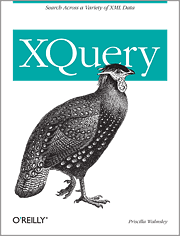Description
The fn:max function finds the maximum of a sequence of values. The $arg sequence can only contain values of one type, or a type derived from it. The one exception is that they can be all numeric (of different numeric types), in which case numeric promotion rules apply. That type must be ordered; it must be possible to compare the values using the < and > operators.
The fn:max function assumes untyped values are numeric unless they are explicitly cast to xs:string. To treat untyped data as strings, use the fn:string function as shown in the last example below.
This description is © Copyright 2007, Priscilla Walmsley. It is excerpted from the book XQuery by Priscilla Walmsley, O'Reilly, 2007. For a complete explanation of this function, please refer to Appendix A of the book. Arguments and Return Type| Name | Type | Description |
|---|
$arg |
xs:anyAtomicType* |
the sequence of values |
$collation |
xs:string |
the collation to use for comparing strings |
| return value |
xs:anyAtomicType? |
Exampleslet $ordDoc := | doc('https://www.datypic.com/functx./input/order.xml') | return |
| XQuery Example | Results |
|---|
max( (2, 1, 5, 4, 3) ) |
5 |
max( ('a', 'b', 'c') ) |
c |
max(
(xs:date('1999-04-15'), current-date()) ) |
The current date |
max( ('a', 'b', 1) ) |
Error FORG0006 |
max( 2 ) |
2 |
max($ordDoc//item/@dept) |
Error, if dept is untyped |
max($ordDoc//item/string(@dept)) |
WMN |
See AlsoHistory |
Recommended Reading: 
|

